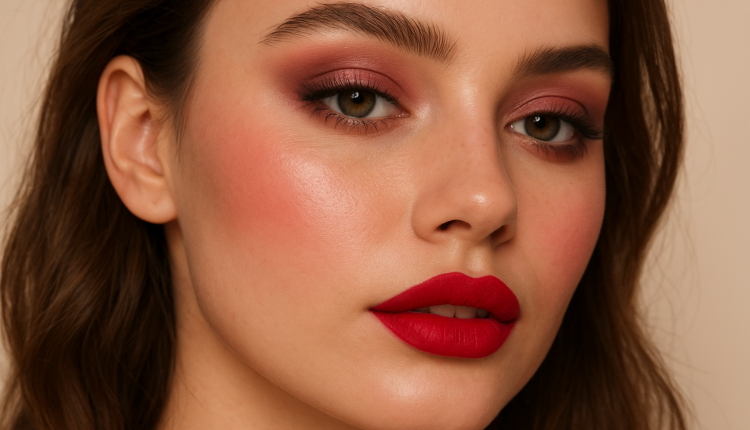Makeup is often seen as a form of art — a way to enhance beauty, express individuality, or align with trends. Yet beyond aesthetics, every hue we apply has the power to evoke emotions, shift perceptions, and even alter how others respond to us. The psychology of color in makeup is a fascinating intersection between beauty and human behavior, revealing how shades of lipstick, blush, and eyeshadow can subtly influence mood, confidence, and self-expression.
The Emotional Power of Color
Colors trigger psychological and physiological responses. Warm tones such as reds, oranges, and pinks tend to stimulate energy, passion, and warmth, while cooler tones like blues and greens evoke calmness and serenity. When applied to makeup, these effects become personal and visible, influencing how wearers feel and how others perceive them.
A classic red lipstick, for example, has long been associated with confidence and empowerment. Studies suggest that wearing red can enhance self-assurance, heighten attraction, and even improve performance in social situations. Conversely, soft nudes or peach tones convey approachability and natural charm, often preferred for professional or casual settings.
Lipstick Shades and Their Subconscious Impact
Lip color remains one of the most powerful tools for nonverbal communication. Each shade carries emotional and social undertones that can shape impressions.
-
Red: Symbolizes power, passion, and assertiveness. It draws attention and signals confidence.
-
Pink: Conveys youth, playfulness, and femininity. Lighter pinks appear gentle, while deeper rose tones add sophistication.
-
Nude: Suggests authenticity and subtle elegance, perfect for understated yet polished looks.
-
Dark Burgundy or Plum: Implies mystery, creativity, and independence, often worn by those unafraid to stand out.
The choice of lipstick often reflects the wearer’s inner mood or desired persona — a silent expression of emotion and intent.
The Role of Eye Makeup in Perception
Eyes are the focal point of human connection, and eye makeup has long been used to amplify their expressiveness. The colors chosen can enhance natural eye tones or create dramatic contrasts that influence perception.
-
Blue Eyes: Warm bronze, copper, and peach tones create harmony by highlighting natural vibrance.
-
Brown Eyes: Almost every color complements brown eyes, but jewel tones like emerald and navy intensify depth.
-
Green Eyes: Shades of mauve, plum, and warm taupe bring out their unique sparkle.
Beyond color, texture plays an important role. Matte shades create depth and sophistication, while shimmer suggests glamour and playfulness. The psychology here is subtle — the more light a surface reflects, the more attention it commands.
Blush and Emotional Warmth
Blush serves as both a beautifying and psychological tool. A flush of pink or coral mimics natural vitality and youthfulness, evoking health and happiness. In fact, studies show that subtle facial redness increases perceived attractiveness, as it subconsciously signals vitality and positive emotion.
Choosing the right tone is crucial:
-
Cool pinks work well on fair skin, enhancing freshness.
-
Peach and coral bring warmth to medium complexions.
-
Deep rose and berry shades flatter darker tones beautifully, emphasizing richness and radiance.
The Influence of Cultural Context
Cultural perceptions of color significantly shape makeup preferences. In Western societies, bold colors like red and black symbolize power and sensuality. In contrast, in parts of Asia, lighter tones represent purity and refinement. In India and the Middle East, gold and rich jewel shades embody celebration and spirituality.
Understanding these nuances helps explain why makeup trends differ globally and how they evolve with shifting beauty ideals. What is considered daring in one culture may be seen as elegant in another.
Makeup as a Mood Enhancer
Color psychology extends beyond outward perception—it affects internal states as well. Many people instinctively reach for specific makeup shades based on how they feel or wish to feel. Applying a vibrant lipstick can lift spirits on a dull day, while a soft neutral palette may provide calm during stressful times.
This “mood makeover” effect demonstrates that makeup is not merely cosmetic—it’s emotional self-care. It enables individuals to align their external presentation with internal emotion, fostering a sense of control and empowerment.
Modern Trends: Minimalism Meets Expression
The current makeup landscape embraces both ends of the spectrum: minimalist “no-makeup” looks that emphasize authenticity, and bold experimental styles that celebrate individuality. Both approaches harness color psychology — whether through the absence of strong pigments to evoke simplicity, or through daring hues that symbolize creativity and rebellion.
For instance, pastel eyeliners and metallic shadows reflect a playful, futuristic optimism, while muted terracotta tones channel earthiness and grounding. Brands now recognize the emotional resonance of color, using it not only to sell products but to promote wellness, inclusivity, and confidence.
Conclusion
The psychology of color in makeup transcends surface beauty. Each shade we choose carries emotional significance, reflecting our moods, intentions, and cultural identities. From the empowering allure of a crimson lip to the soothing calm of a nude palette, makeup is both an art and a language — one that speaks without words.
Understanding color psychology allows us to make more conscious choices, transforming our daily beauty routines into acts of self-expression and emotional awareness. In the end, makeup is not about hiding behind color but about revealing emotion, personality, and power through it.


